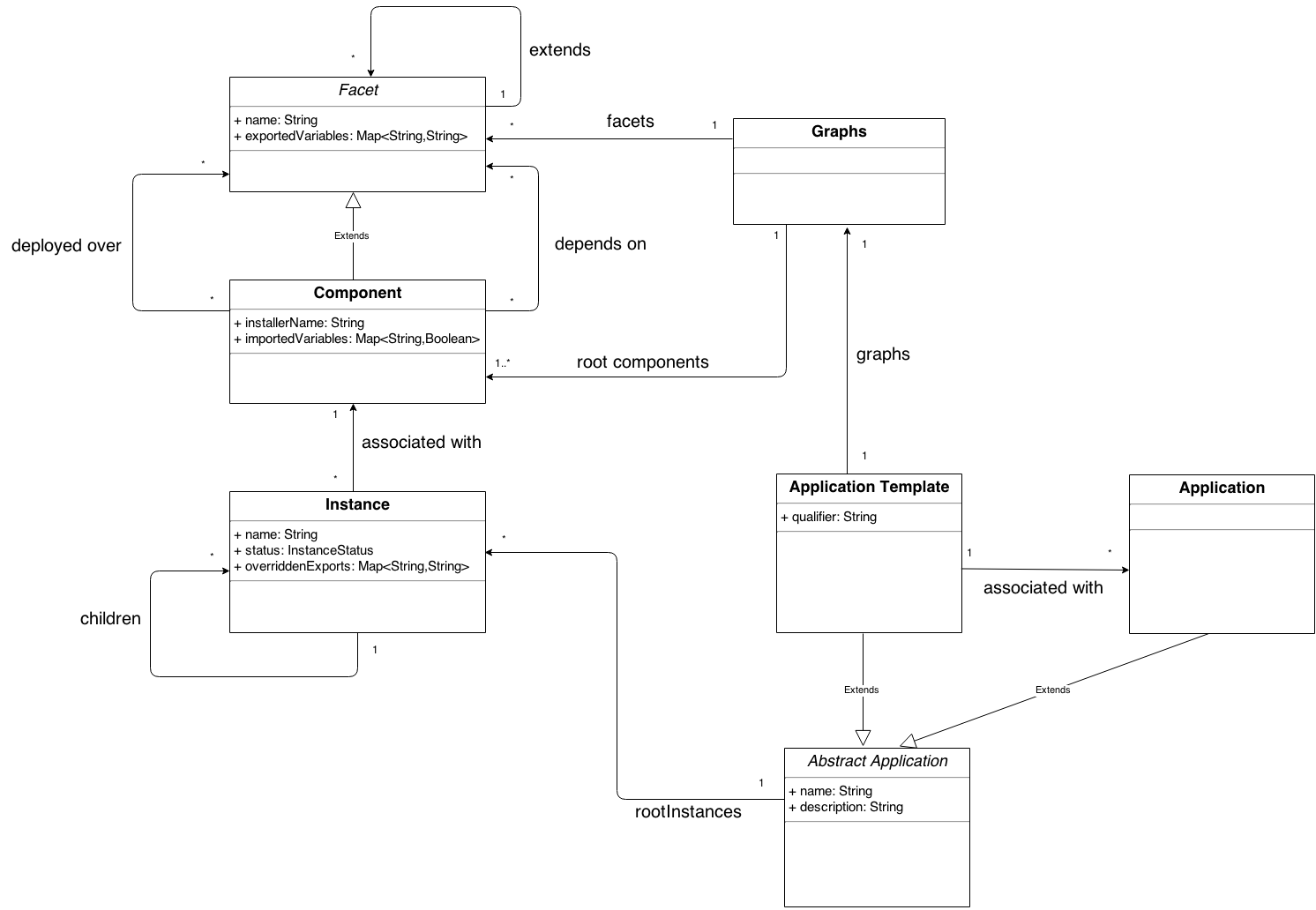OCCI Model for Roboconf
This page aims at specifying an OCCI-compliant extension for Roboconf.
The OCCiware project defined an EMF meta-model. The global idea is to map Roboconf concepts
as OCCI resources, links, mix-ins, etc.
Roboconf Concepts
Roboconf has the following concepts.
- Application template
- Application
- Graphs (which wraps types definitions)
- Facet (which is an abstract type)
- Component (which is a concrete type)
- Instance (which is an instanced type)
And there are various relations between these concepts.
Class Diagram
The following class diagram illustrates the relations between Roboconf concepts.
Notice that instance data are not present in the model, there are considered like a developer trick rather than a real concept.
Same thing for instance imports, which are runtime structures and do not aim at being manipulated by users.

A SVG version is also available.
As usual with draw.io diagrams, sources are available on Roboconf’s web site resources.
This diagram may look ugly.
Let’s detail it a little bit.
- An application and an application template share common properties.
- An application is always created from a template.
- An application template always has a graph.
- An application may have any number of root instances.
-
Facets and components are types.
- Various relations exist between types.
- A type may be instantiated only within another type. It is a hierarchy relation.
- A type may depend on other types (dependency / variable resolution). It is a runtime relation.
- A type may inherit properties from another type. It is an inheritance relation.
- Component extends Facet. So, every behavior available for a facet also exists for a component.
- Only components can have hierarchical and runtime relations. In this context, a facet designates all the components that inherit from this facet.
- An instance is associated with only one component.
Model Constraints
There are also some constraints that cannot be represented on the class and OCCI diagrams.
In the ecore model, they are translated as OCL constraints.
Here is a textual definition of these constraints.
1: comp-ext-one-comp
A component can only extend directly one component.
You can compare facets to Java interfaces and components to Java classes.
Like the diagram suggests it, a component can extend any number of facets.
2: facet-cannot-ext-itself
A facet cannot extend (directly or indirectly) itself.
3: comp-cannot-deploy-over
A component cannot be deployed (directly or indirectly) on itself (prevent cycle).
This may be seen as a limit for Docker containers, but they should be modeled differently according to their use,
even if they share the same configuration (think about debug and support).
4: comp-optional-dep
A component cannot depend on itself, unless the dependency is optional.
5: root-components
Graphs root components cannot not have any (hierarchical) parent.
6: root-instances
Applications root instances cannot have any (hierarchical) parent.
7: instance-and-graph-coherence
Instance hierarchy must be coherent with the component hierarchy.
Said differently, if instance A is a child of instance B, then the component (of instance) B must be a
(hierarchical) parent of the component A.
8: graph-facets-are-facets
Graphs facets can only be facets, and not components.
Notice that all these constraints are already checked in the Roboconf validator.
Except the Roboconf validator works on Roboconf classes and not on an OCCI-compliant meta-model.
OCCI Mapping
Defining concepts and their relations is classic modeling.
However, we cannot simply map concepts to create an OCCI extension. After we tried to do it, we found it
was not the right way.
Here is a methodology we adopted.
- Define a use case. Why do you want to use OCCI?
- Model the concepts you need for this use case.
- Iterate if you have several use cases. It is also possible to define several extensions.
Within the scope of Roboconf, here are the use cases we want to cover with OCCI.
-
Provide an OCCI-compliant REST API, in addition to our own REST API.
An OCCI-compliant REST API only needs instances concepts. It was decided it would be better to try to fit into the OCCI Platform model. It may require some modifications in this specification to make it more flexible (it is mainly oriented towards developer PaaS such as Cloud Foundry, Openshift, etc). This work is mainly led by academic partners of the OCCiware project. -
Be able to interact with OCCI-compliant resources (such as IaaS).
This has nothing to do with Roboconf concepts. It is all about creating a dedicated plug-in or target for OCCI infrastructure. -
Implement code generators that will be plugged with OCCI tools.
This part will require its own OCCI extension to define Roboconf concepts, such as the graph, instances and so on.